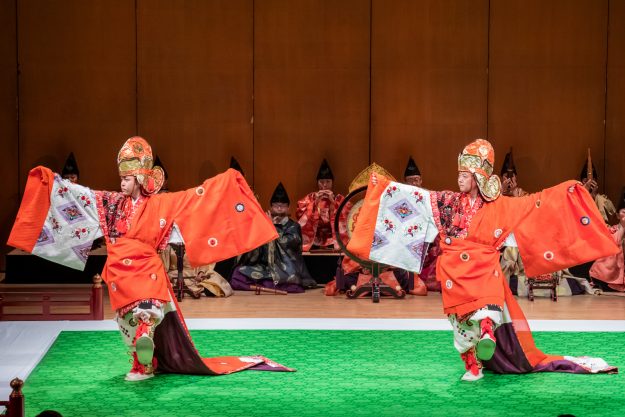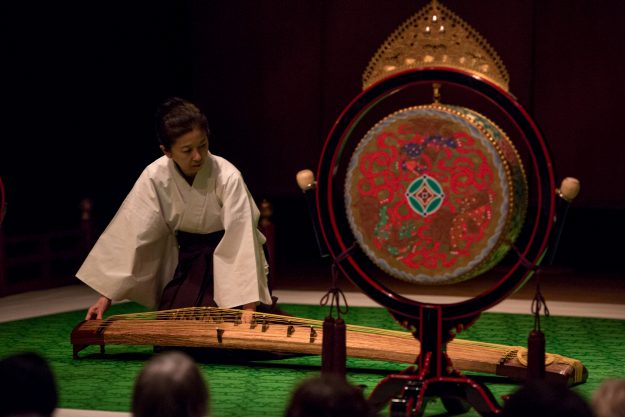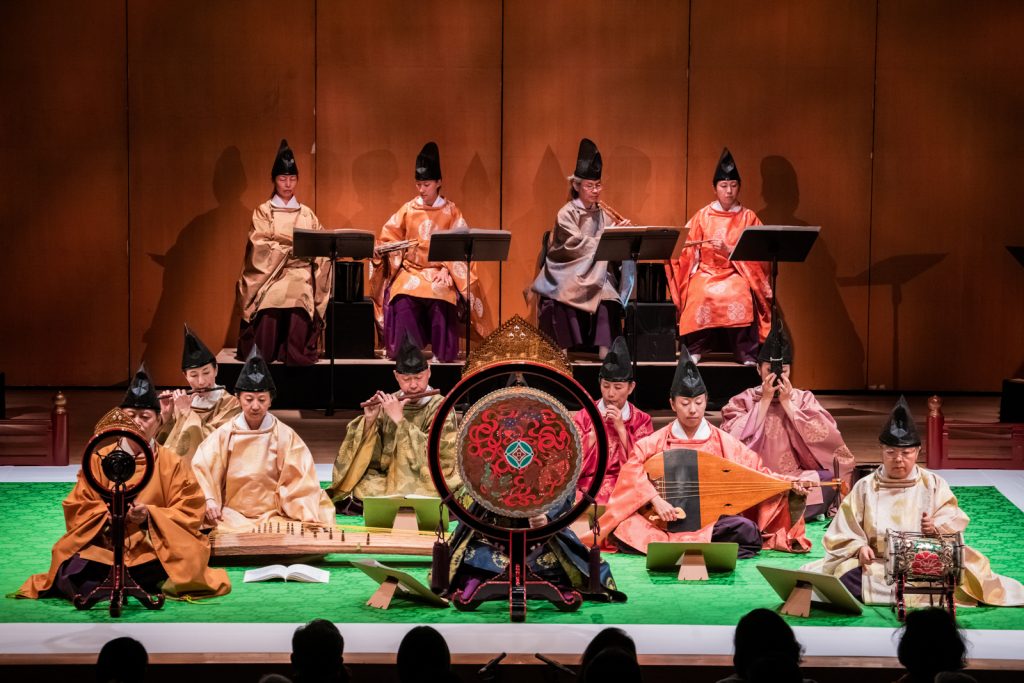A small ensemble silently steps out in single file. Dressed in clothing from Japan’s Heian period (794 to 1185), rounded-collared sokutai robes and tall black eboshi hats, they kneel beside an array of ancient instruments and offer a deep bow. Then a haunting harmony rises out of a mouth organ (sho) and the percussionists roll in like a distant march. Hichiriki (oboes with a bag-pipe-like quality), wooden flutes, and long twangy string instruments join in, creating a rich chorus of both wailing and triumphant voices.
This is how the Reigakusha ensemble began their recent performance of gagaku, Japanese court music, at the Japan Society in New York City. The style dates back to the 6th century, when it crossed the sea from China and Korea alongside Buddhism. When the conflicts of the Warring States period (in the 15th to 17th centuries) threatened to eliminate gagaku and the accompanying dance bugaku, Buddhist temples kept the artform alive through performances at annual ceremonies.

Today, the average Japanese citizen likely has heard of gagaku, though few know much about it, Japan Society artistic director Yoko Shioya told Tricycle. But that’s changing: Around 15 years ago, music education in Japanese schools started shifting its focus from Western classical music to include more lessons about traditional Japanese performing arts, Shioya said. Then, in 2009, UNESCO added gagaku to its Intangible Cultural Heritage List, calling it a “crystallization of the history of Japanese society” and a “demonstration of how multiple cultural traditions can be fused into a unique heritage.”
Reigakusha is helping to make a gagaku revival possible through its classical demonstrations as well as by performing new reigaku, or neo-gagaku, compositions arranged for the traditional 17-person ensemble. The Japan Society program on September 21 was split into two parts, ancient gagaku and neo-gagaku. Gagaku is performed without a conductor, a feat rarely attempted by ensembles of that size in the world of Western classical music. The musicians also did not use sheet music for the ancient portion. After the intermission, however, the performers returned with music stands to play two reigaku compositions: “Shotorashion” and “In an Autumn Garden” (Shuteiga).
“Shotorashion” was composed by Reigakusha’s founder, Sukeyasu Shiba. He named the work after Shotora, one of the 12 divine generals in Japanese Buddhism, as a nod to the history that gagaku and the dharma share. The final work, “In an Autumn Garden” (Shuteiga), was written by Toru Takemitsu for the National Theatre in Tokyo in 1973. Takemitsu (1930–1996) was a pioneer of contemporary gagaku and a major influence for Shiba, who established the Reigakusha ensemble in 1985 to continue Takemitsu’s work.
Shiba died two months ago. Under his leadership, the ensemble toured the world and expanded its repertoire of classical, contemporary, and revived compositions. In artistic director Shioya’s note for the program, she dedicated the concert to Shiba, writing, “I hope he is smiling in Nirvana, watching New Yorkers enjoy and adore his ensemble’s performance.”
The Reigakusha concert kicked off the Japan Society’s 2019–20 season.

Thank you for subscribing to Tricycle! As a nonprofit, we depend on readers like you to keep Buddhist teachings and practices widely available.
